研究生英语精读教程
- 格式:doc
- 大小:74.00 KB
- 文档页数:17
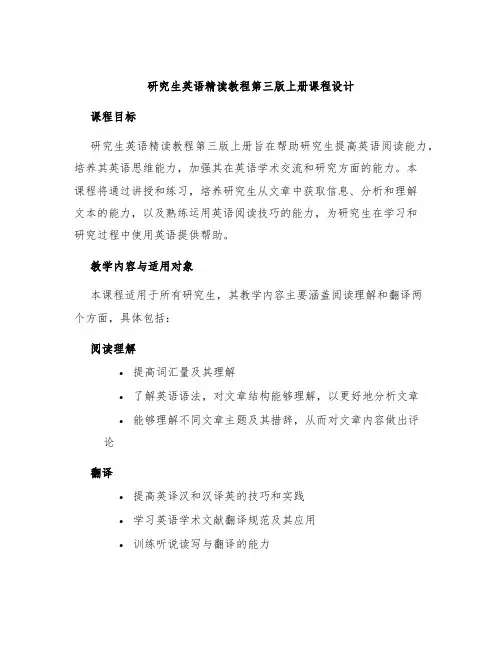
研究生英语精读教程第三版上册课程设计课程目标研究生英语精读教程第三版上册旨在帮助研究生提高英语阅读能力,培养其英语思维能力,加强其在英语学术交流和研究方面的能力。
本课程将通过讲授和练习,培养研究生从文章中获取信息、分析和理解文本的能力,以及熟练运用英语阅读技巧的能力,为研究生在学习和研究过程中使用英语提供帮助。
教学内容与适用对象本课程适用于所有研究生,其教学内容主要涵盖阅读理解和翻译两个方面,具体包括:阅读理解•提高词汇量及其理解•了解英语语法,对文章结构能够理解,以更好地分析文章•能够理解不同文章主题及其措辞,从而对文章内容做出评论翻译•提高英译汉和汉译英的技巧和实践•学习英语学术文献翻译规范及其应用•训练听说读写与翻译的能力教学进程本课程为16周,每周两节课,每节课120分钟,每周教学内容如下:第一周•介绍课程教材和学习要求•分析和总结一篇英文短文•提高英文阅读的技巧第二周•提高英文词汇量•阅读并理解和掌握一篇英文信息类文章•练习阅读和分析一篇英文研究论文第三周•了解英语语法•阅读并分析一篇固定语态的学术论文•翻译一篇英文抽象第四周•分析一篇学术论文的结构•阅读并分析一篇医学论文•提高英语阅读和理解能力第五周•提高英语翻译的能力•翻译一篇学术文章的摘要•听听力并练习阅读第六周•熟练掌握英语科技论文写作标准•阅读一篇与化学有关的学术文章并进行分析和译文•概述文献和成果的完整性第七周•阅读一篇与工程学相关的学术文章•实现英译汉和汉译英的能力提高,包括写出清晰和简明的译文•练习论文写作第八周•阅读一篇与经济学相关的学术文章•熟练掌握文章分析技巧•理解行文时段落内容第九周•阅读一篇与计算机科学相关的学术文章•熟悉学术论文的格式•小组阅读并作翻译练习第十周•阅读一篇与社会学相关的学术文章•熟悉学术英语写作的基本方法•小组阅读并作翻译练习第十一周•阅读并翻译一篇英文新闻报道•小组阅读并作文献摘录练习•分析一篇较难的学术论文第十二周•阅读并翻译一篇英文科技论文•小组阅读并作文献摘录练习•实现英译汉和汉译英的能力进一步提高第十三周•进行阅读和分析一组医学相关学术论文•熟练掌握论文写作规范•进一步练习阅读和翻译技巧第十四周•阅读一篇与生态学相关的学术文章•团队协作完成一篇研究性学术论文•分析一篇不同风格的学术论文写作第十五周•阅读一篇与商业管理相关的学术文章•总结课程学习内容及其进展•小组演讲第十六周•总结课程学习成果•进行口语考试•提交作业评分标准本课程最终成绩将包括以下部分:期中考试(30%)、日常作业及参与(30%)以及期末考试(40%)。
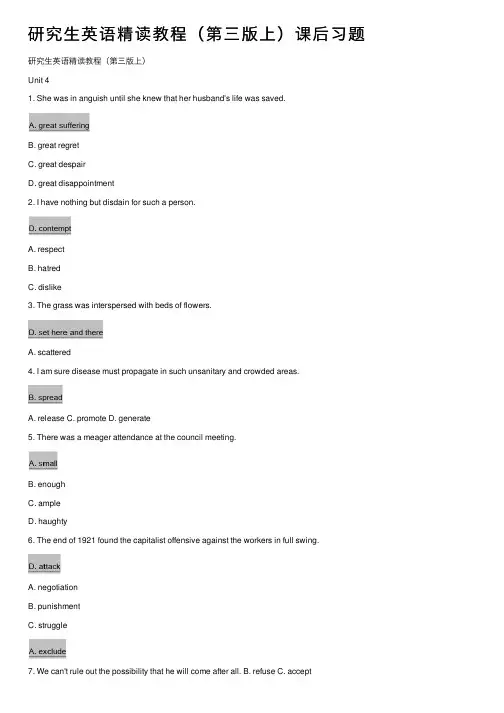
研究⽣英语精读教程(第三版上)课后习题研究⽣英语精读教程(第三版上)Unit 41. She was in anguish until she knew that her husband's life was saved.B. great regretC. great despairD. great disappointment2. I have nothing but disdain for such a person.A. respectB. hatredC. dislike3. The grass was interspersed with beds of flowers.A. scattered4. I am sure disease must propagate in such unsanitary and crowded areas.A. release C. promote D. generate5. There was a meager attendance at the council meeting.B. enoughC. ampleD. haughty6. The end of 1921 found the capitalist offensive against the workers in full swing.A. negotiationB. punishmentC. struggle7. We can't rule out the possibility that he will come after all. B. refuse C. accept8. John was confined to bed for a week with his cold.A. allowed in C. tied to D. shut on9. We three were the sole survivors in the traffic accident.A. luckyB. fortunateC. blessed10. I slept through her dull speech.A. dozing C. fascinating D. imaginative11. I have been in _________ with him about the matter.A. lettersB. dealingsC. writings12. I could hear only __________ of their conversation.A. piecesB. slips D. portions13. The old lady ______ the sweet-smelling flowers into a garland. A. tied C. curvedD. twisted14. A ______ man will stop at nothing to get what he wants.B. prudentC. shrewdD. rude15. Most bacteria grow best in a slightly acid ______.B. placeC. district16. Everyone knows that the firefly is a _____ insect.A. firingB. lighting D. glowing17. Sports, and not learning, seem to ______ in that school. A. appear B. occupy D. lead18. Each chess player will have five minutes to ______ his next move. A. make B. have C. take19. This time they really ______ better results.A. hoped C. wished D. wished to20. ______ came of his success abroad.C. WordsD. The wordUnit 51. His beautiful writing is akin to drawing.A. asB. fromC. above2. His knowledge on the subject seems to be on a par with my own. A. different fromC. related toD. in accordance with3. Tom and Mary were married a week after they met and soon found themselves at odds about religion.4. The inventor was vilified in yesterday's newspaper.A. abused C. praised D. criticized5. The Mississippi flood of 1973 was a major catastrophe in which a great many lives were lost.A. casualty C. change D. threat6. She almost yielded to an unexpected impulse to dance in the street. A. urgent desireC. good ideaD. fancy thought7. Mr. Green posed as a rich man though he owed more than he owned.A. workedB. lookedB. IllnessC. troubleD. ailment9. Some people have a bias against foreigners.B. dislikeC. hatredD. favour10. Your stay abroad will give you ample opportunities to learn a new language.A. goodB. suitableC. proper11. The dark clouds suggest a(n) ______ storm.B. surprisingC. fastD. unexpected12. Since the club owed $15 and had only $10 in the treasury, there was a ______ of $5.A. sum C. difference D. surplus13. The oil lamp ______ softly on the table.A. glowedB. lighted D. sounded14. It ______ with you to decide.A. talksB. refers D. indicates15. He ______ among the best heavyweight boxers of the past fifty years.A. projectsB. showsC. displays16. The constant turmoil in the office proved that he was an ______ administrator.A. able C. experienced D. active17. The mother tried to ______ her son’s interest in music by taking him to concerts when he was young.A. giveB. show D. cause18. No matter how you read it, this sentence doesn’t make any __. A. meaning B. sound C.progress19. I tried to find my keys but I was ______ by my thick gloves. A. helped C. annoyedD. upset20. To our grief, he became ______ to the drug.B. interestedC. amusedD. disturbedUnit61. The patient clenched the arms of the dentist's chair.B. touchedC. placed onD. pressed2. The retiring professor was exalted by his colleague.A. criticized D. examined3. All the tourists were impressed by the amazing grandeur of Niagara Falls.A. power C. speed D. height4. We stared in awe at the president himself.B. concernC. satisfactionD. envy5. The term “paper”is a little misleading when you consider the strength and endurance of the construction material.B. uniqueC. elementD. current status6. When the moon wanes, it changes from the full to the new phase.7. Edward Ⅷrelinquished his throne to marry Mrs. Simpson.8. The teacher had unusual insight into children’s emotions and knew clearly how to treat them.9. Have you seen the new edifice of Elm Street?10. Property on which money has been lent is redeemed when the loan is paid back.D. discharged11. She practiced the speech until her delivery and timing were completely ______.A. faulty12. He is an honest person. His actions are always ______ his words.A. contradictory toB. contradicted byC. agreed with13. They called for "immediate, absolute, ______ separation from the North" and elected their own president, Jefferson Davis.friendly B. lifelong D. lasting14. Charles _____ to the rope his would-be rescuers had thrown to him.A. heldB. graspedC. gripped15. This revived all my _______ love of scienceD. enthusiastic16. He is doing an _______ course in physics.A. intenseB. internalC. instant17. I don't care what you do about your job; it's no ______ of mine.D. subject18. He was disappointed by his result, but he is now ______ to having to retake the exam.D. supposed19. Americans ______ with but one primitive bathroom on each floor revolted in horror.A. facing20. Giving presents at Christmas is ______ in the West.D. a law1.这些年轻的⼯⼈技术员具备我们能希望他们有的⼀切条件。
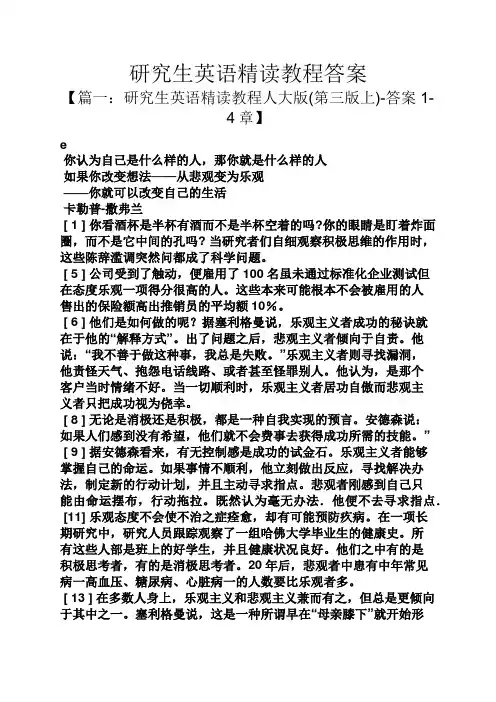
研究生英语精读教程答案【篇一:研究生英语精读教程人大版(第三版上)-答案1-4章】e你认为自己是什么样的人,那你就是什么样的人如果你改变想法——从悲观变为乐观——你就可以改变自己的生活卡勒普-撒弗兰[ 1 ] 你看酒杯是半杯有酒而不是半杯空着的吗?你的眼睛是盯着炸面圈,而不是它中间的孔吗? 当研究者们自细观察积极思维的作用时,这些陈辞滥调突然问都成了科学问题。
[ 5 ] 公司受到了触动,便雇用了100名虽未通过标准化企业测试但在态度乐观一项得分很高的人。
这些本来可能根本不会被雇用的人售出的保险额高出推销员的平均额10%。
[ 6 ] 他们是如何做的呢?据塞利格曼说,乐观主义者成功的秘诀就在于他的“解释方式”。
出了问题之后,悲观主义者倾向于自责。
他说:“我不善于做这种事,我总是失败。
”乐观主义者则寻找漏洞,他责怪天气、抱怨电话线路、或者甚至怪罪别人。
他认为,是那个客户当时情绪不好。
当一切顺利时,乐观主义者居功自傲而悲观主义者只把成功视为侥幸。
[ 8 ] 无论是消极还是积极,都是一种自我实现的预言。
安德森说:如果人们感到没有希望,他们就不会费事去获得成功所需的技能。
”[ 9 ] 据安德森看来,有无控制感是成功的试金石。
乐观主义者能够掌握自己的命运。
如果事情不顺利,他立刻做出反应,寻找解决办法,制定新的行动计划,并且主动寻求指点。
悲观者刚感到自己只能由命运摆布,行动拖拉。
既然认为毫无办法.他便不去寻求指点. [11] 乐观态度不会使不治之症痊愈,却有可能预防疚病。
在一项长期研究中,研究人员跟踪观察了一组哈佛大学毕业生的健康史。
所有这些人部是班上的好学生,并且健康状况良好。
他们之中有的是积极思考者,有的是消极思考者。
20年后,悲观者中患有中年常见病一高血压、糖尿病、心脏病一的人数要比乐观者多。
[ 13 ] 在多数人身上,乐观主义和悲观主义兼而有之,但总是更倾向于其中之一。
塞利格曼说,这是一种所谓早在“母亲膝下”就开始形成的思维模式,来自千万次警告或鼓励,积极的或消极的话语。
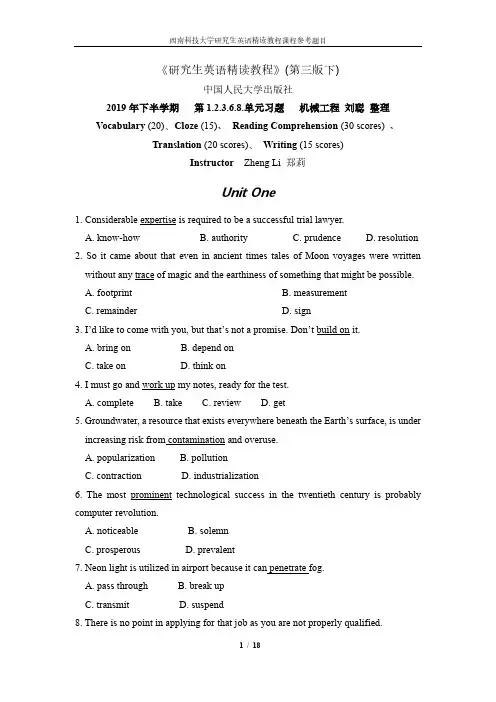
《研究生英语精读教程》(第三版下)中国人民大学出版社2019年下半学期第1.2.3.6.8.单元习题机械工程刘聪整理Vocabulary (20)、Cloze (15)、Reading Comprehension (30 scores) 、Translation (20 scores)、Writing (15 scores)Instructor Zheng Li 郑莉Unit One1. Considerable expertise is required to be a successful trial lawyer.A. know-howB. authorityC. prudenceD. resolution2. So it came about that even in ancient times tales of Moon voyages were written without any trace of magic and the earthiness of something that might be possible.A. footprintB. measurementC. remainderD. sign3. I’d like to come with you, but that’s not a promise. Don’t build on it.A. bring onB. depend onC. take onD. think on4. I must go and work up my notes, ready for the test.A. completeB. takeC. reviewD. get5. Groundwater, a resource that exists everywhere beneath the Earth’s surface, is under increasing risk from contamination and overuse.A. popularizationB. pollutionC. contractionD. industrialization6. The most prominent technological success in the twentieth century is probably computer revolution.A. noticeableB. solemnC. prosperousD. prevalent7. Neon light is utilized in airport because it can penetrate fog.A. pass throughB. break upC. transmitD. suspend8. There is no point in applying for that job as you are not properly qualified.A. reasonB. resultC. chanceD. use9. It is estimated that almost one million earthquakes occur each year, but most of them are so minor that they pass undetected.A. with no damageB. with no noticeC. with no nameD. with no problem10. Inspired by another movement in art called Dadaism, the Surrealist movement has been one of the most influential art movements in the 20th century.A. DespisedB. InfluencedC. StifledD. Created11. In less than a millionth of a second, the vast computer of an international airline can ______ accept 800 booking inquiries, and search its 50 million memory units for appropriate replies.A. simultaneouslyB. implicitlyC. complacentlyD. cautiously12. There are two hundred and forty stamps in the sheet, arranged in twenty rows of twelve stamps _____.A. individuallyB. acrossC. horizontallyD. vertically13. Many of the conditions that _____ population pressures—overcrowding, unemployment, poverty, hunger and illness—lead to dissatisfaction.A. bring forwardB. bring outC. result inD. result from14. A severe illness _____ the hot weather has left the baby very weak.A. in accordance withB. in line withC. in conjunction withD. in agreement with15. It is a long time since we’ve been ____; I hope everything goes as well as last time.A. united upB. brought upC. teamed upD. picked up16. An increasing proportion of our population, unable to live without advanced medical ____, will become progressively more reliant on expensive technology. A. interaction B. interferenceC. interventionD. interruption17. In what _____ to a last minute stay of execution, a council announced that emergency funding would keep alive two aging satellites.A. appliesB. accountsC. amountsD. attaches18. Despite their good service, most inns are less costly than hotels of _____ standards.A. equivalentB. alikeC. uniformD. likely19. It has been estimated that earthquake-related fatalities have numbered in the millions and earthquake-related destruction has been _____ calculation.A. underB. overC. behindD. beyond20. We’re in a _____ position here, with the enemy on the hill above us.A. strongB. powerfulC. vulnerableD. negativeB. Put the following into English.1. 超级市场连同消费者都遭到了通货膨胀的沉重打击。
![研究生英语精读教程[上册]Unit 2](https://uimg.taocdn.com/fa8e0feb9b89680203d82526.webp)
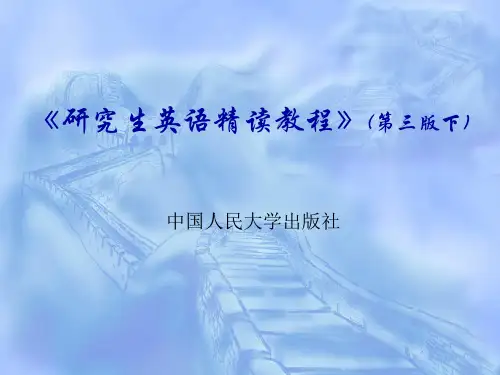
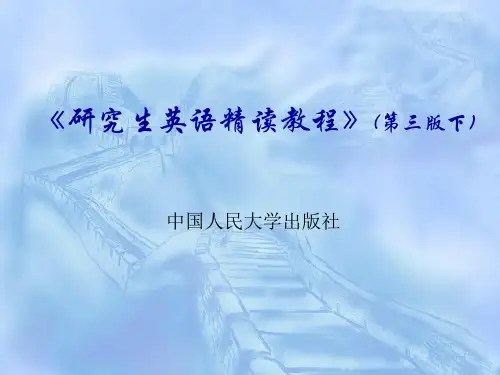
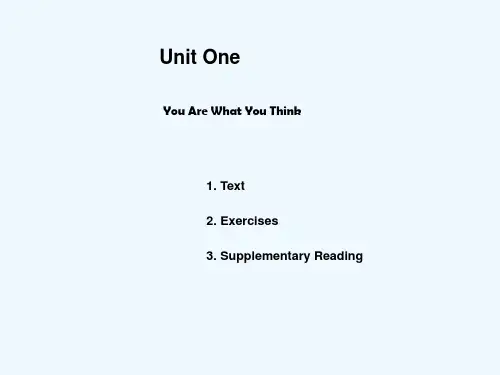
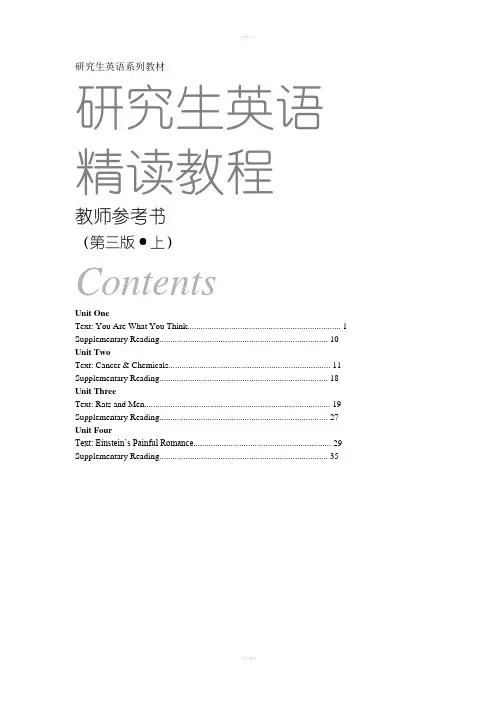
研究生英语系列教材研究生英语精读教程教师参考书(第三版·上)ContentsUnit OneText: You Are What You Think (1)Supplementary Reading (10)Unit TwoText: Cancer & Chemicals (11)Supplementary Reading (18)Unit ThreeText: Rats and Men (19)Supplementary Reading (27)Unit FourText: Einstein’s Painful Romance (29)Supplementary Reading (35)Unit FiveText: The End Is Not at Hand (37)Supplementary Reading (44)Unit SixText: Two Truths to Live By (47)Supplementary Reading (58)Mini-Test Ⅰ (59)Unit SevenText: Good Taste, Bad Taste (61)研究生英语精读教程教师参考书(第三版/上)Supplementary Reading (70)Unit EightText: I Have a Dream (73)Supplementary Reading (80)Unit NineText: This Was My Mother (81)Supplementary Reading (91)Unit TenText: Digital Revolution: How the Korean Group Becamea Global Champion (93)SupplementaryReading (100)Unit ElevenText: In Search of the Real Google (101)Supplementary Reading (118)Unit TwelveText: A Red Light for Scofflaws (119)Supplementary Reading (129)Mini-Test Ⅱ (131)►Text:You Are What You ThinkClaipe SafranLanguage Points1. Para. [2]: mental illsWhen used as a noun, “ill” means “anything causing harm, trouble,wrong,un happiness, etc., specifically: a) an evil or misfortune; b) a disease”.Its synonyms in this lesson: disease (Para.10), ailments(Para.11), illness (Para.11)Other synonyms: sickness, ailing, infirmity, indisposition, complaint, disorder, malady, distemper2. Para. [7]: When they failed on the first call or two ...When the first few people they phoned refused to donate blood ...3. Para. [8]: self-fulfilling prophecya prediction brought to fulfilment chiefly as an effect of having been expected or predicted4. Para. [9]: A sense of control ... is the litmus test for success.Whether one feels in control of the situation will determine if one succeedsin the end.5. Para. [10]: ... think they are better than the facts would justify ...overestimate themselves; regard themselves as better than they really are 6. Para. [13]: at one’s m other’s kneewhen one is a small child研究生英语精读教程教师参考书(第三版/上)Word Study1. donate v.donation n.donator n.①He donated all his savings to the village school.②They have donated to the Red Cross.③The van was donated to us by a local firm.④The new library has received a generous donation of 200 rare books from its favourite patron.⑤He made a donation of $1,000 to the children’s hospital.⑥The Famine Relief Fund has received 500 yuan in cash from an anonymous donator.2. recur v.recurring adj.recurrent adj.recurrence n.①He is more concerned about those problems which recur periodically.②If you divide 10 by 3, the result will be a recurring decimal.③Lack of confidence in himself will be a recurring problem for him in the future.④The patient complained of a recurrent headache.⑤He was aware of the possibility of recurrence of his illness.⑥His words of encouragement recurred to my mind whenever I was in low spirits.3. immune (to/against/from) adj.immunity n.immunize v.immunology n. study of resistance to infection①He seems to be immune to flattery.②We are immune from smallpox as the result of vaccination.③The child has received immunity to a variety of infections.Unit One④He was given immunity from taxation on the ground that he had been seriously injured.⑤Ambassadors enjoy diplomatic immunity in the countries in which they are stationed.⑥Everyone who is going abroad will need to be immunized againsttyphoid.⑦The government is going to spend more money on its immunizationprogram.⑧He has devoted all his life to immunology.4. caution n. & v.cautious adj.①You must exercise extreme caution when you cross this street.②The police gave him a caution for speeding.③The policeman cautioned the motorist about his speed.④They cautioned him about danger.⑤His teacher cautioned him that he might fail his exam.⑥If I had been less cautious, I might have made greater progress.⑦They are very cautious of/about giving offence.⑧He walked cautiously in this unknown territory.5. triumph n. & v.triumphant adj.①The conquest of outer space is one of the greatest triumphs of modernscience.②His life was a triumph over ill health.③Though he had beaten his opponent in the election, they could detect notriumph in his eye.④Grinning broadly, he held up the prize in triumph.⑤Justice triumphs in the end.⑥He triumphed over many difficulties.⑦Her triumphant smile told me how proud she was of her success.⑧Having succeeded at his first attempt, the boy looked at me triumphantly.研究生英语精读教程教师参考书(第三版/上)参考译文你认为自己是什么样的人,那你就是什么样的人如果你改变想法——从悲观变为乐观——你就可以改变自己的生活卡勒普·撒弗兰[1] 你看酒杯是半杯有酒而不是半杯空着的吗?你的眼睛是盯着炸面圈,而不是它中间的孔吗? 当研究者们仔细观察积极思维的作用时,这些陈词滥调突然间都成了科学问题。
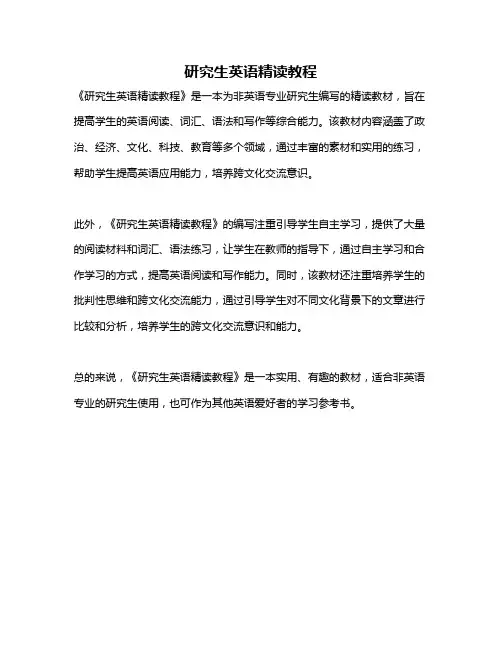
研究生英语精读教程
《研究生英语精读教程》是一本为非英语专业研究生编写的精读教材,旨在提高学生的英语阅读、词汇、语法和写作等综合能力。
该教材内容涵盖了政治、经济、文化、科技、教育等多个领域,通过丰富的素材和实用的练习,帮助学生提高英语应用能力,培养跨文化交流意识。
此外,《研究生英语精读教程》的编写注重引导学生自主学习,提供了大量的阅读材料和词汇、语法练习,让学生在教师的指导下,通过自主学习和合作学习的方式,提高英语阅读和写作能力。
同时,该教材还注重培养学生的批判性思维和跨文化交流能力,通过引导学生对不同文化背景下的文章进行比较和分析,培养学生的跨文化交流意识和能力。
总的来说,《研究生英语精读教程》是一本实用、有趣的教材,适合非英语专业的研究生使用,也可作为其他英语爱好者的学习参考书。
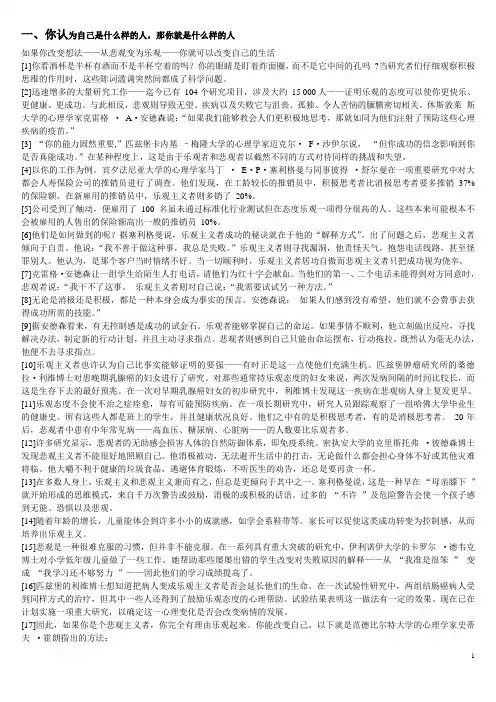
一、你认为自己是什么样的人,那你就是什么样的人如果你改变想法——从悲观变为乐观——你就可以改变自己的生活[1]你看酒杯是半杯有酒而不是半杯空着的吗?你的眼睛是盯着炸面圈,而不是它中间的孔吗?当研究者们仔细观察积极思维的作用时,这些陈词滥调突然间都成了科学问题。
[2]迅速增多的大量研究工作——迄今已有104个研究项目,涉及大约15 000人——证明乐观的态度可以使你更快乐、更健康、更成功。
与此相反,悲观则导致无望、疾病以及失败它与沮丧、孤独、令人苦恼的腼腆密切相关。
休斯敦莱斯大学的心理学家克雷格·A·安德森说:“如果我们能够教会人们更积极地思考,那就如同为他们注射了预防这些心理疾病的疫苗。
”[3] “你的能力固然重要,”匹兹堡卡内基–梅隆大学的心理学家迈克尔·F·沙伊尔说,“但你成功的信念影响到你是否真能成功。
”在某种程度上,这是由于乐观者和悲观者以截然不同的方式对待同样的挑战和失望。
[4]以你的工作为例。
宾夕法尼亚大学的心理学家马丁·E·P·塞利格曼与同事彼得·舒尔曼在一项重要研究中对大都会人寿保险公司的推销员进行了调查。
他们发现,在工龄较长的推销员中,积极思考者比消极思考者要多推销37%的保险额。
在新雇用的推销员中,乐观主义者则多销了20%。
[5]公司受到了触动,便雇用了100名虽未通过标准化行业测试但在态度乐观一项得分很高的人。
这些本来可能根本不会被雇用的人售出的保险额高出一般的推销员10%。
[6]他们是如何做到的呢?据塞利格曼说,乐观主义者成功的秘诀就在于他的“解释方式”。
出了问题之后,悲观主义者倾向于自责。
他说:“我不善于做这种事,我总是失败。
”乐观主义者则寻找漏洞,他责怪天气,抱怨电话线路,甚至怪罪别人。
他认为,是那个客户当时情绪不好。
当一切顺利时,乐观主义者居功自傲而悲观主义者只把成功视为侥幸。
[7]克雷格·安德森让一组学生给陌生人打电话,请他们为红十字会献血。
Unit 11.词汇(1)subsidize(资助)treatment (2)slippery (滑的)slope (3)as an advocate(提倡、主张) (4)our mandate(颁布批准)(5)champion (支持拥护)necessary(6)how to navigate(驾驶航行导航)(7)embolden(壮胆,增加勇气)consumers (8)have an incentive( 动机) (9)need not be justified (证明有理)(10)has no precedent(先例)2.完形填空smoking ban or smoker-ban? 第一句:we all know now that…..(1)budget (2)explosion (3)premises (4)incentives (5)cessation (6)implications (7)ill (8)a slippery slope (9)screening (10)advocates (11)unemployment (12)disparate (13)substantially (14)impractical (15)spots (16)distraction (17)implementation (18)wellness (19)unleashed (20)innovative3.汉译英1) 中国政府致力于打击各行各业的腐败现象(China’s government is making an effort to crack down on corruption in different walks of life.)2) 研究发现,烟民倾向于集体戒烟…(The study finds smokers tend to quit in groups, which means smoking cessation programs should work best if they focus on groups rather than individuals.)3) 随着ATC协议于2005年….(With the termination of the ATC agreement on January 1st, 2005, trade in textiles and clothing will be fully integrated into the multilateral trading system of WTO.)4) 它还能帮助你更好….(It can also help you feel more in control of your emotions and thoughts and help improve your attitude, health, and sense of well-being).5) 我通常都不会接受迟到的申请…..(I don't usually accept late applications, but since you were so sick I'll make an exception.)6) 这些著名大学并未禁止…(The famous Universities are not trying to turn away all the visitors, but merely adding some restrictions on the number of certain groups of visitors.)7)我的发现为两种说法都提供了一些想法(My findings add a new wrinkle to each scenario.)8) 由于2007年底政府竭力避免…(Bank lending was weak in late 2007 when the government was trying to prevent the economy from overheating, which makes comparisons tricky.)Unit 21.词汇(1)encompass(涉及到) cooperation (2)in full frenzy(暴怒,狂乱) (3)dutifully(尽责的,服从的) arrange (4)intangible(不能触摸的)cultural heritage (5)courtship(求爱)and marriage (6) spend lavishly(过分的慷慨大方)to set a bad (7)discounted(打折)tickets (8)incur (遭遇,获得)the ignominy (9)subscribe(订阅、认购)to the newspaper (10)designate(指出,指示)a member2.完形填空T celebrate valentine’s day in the low-budget eco-friendly way (while many of us were happily…)(1)embracing (2)preoccupied (3)geared (4)money-making (5)comments(6)costly (7)sincere (8)commercial (9)romantic (10)dedicated (11)Impress (12)generous (13)outcome (14)generate (15)eco-friendly(16)designed (17)upload (18)personal (19)discount (20)minimum3.汉译英1)过去五年间,老百姓的实际…Real disposable income has nearly doubled in the past five years and is growing by more than 10% a year.2)我们在此受到了隆重的接待…It gives me great pleasure to express once again to our host my deep appreciation for the grand reception and generous hospitality we enjoy here.3) 然而现在,许多国家正..But now it is being considered quite seriously by many nations, especially since scientists have warned, that the human race will outgrow its fresh water supply faster than it runs out of food.4)然而,政府消减排放量… The demise of cap and trade in Congress, however, does not call a complete halt to the administration's efforts to cut emissions.5) 自那以来,尽管一些楼盘..Since then, it has sold a grand total of one flat, although the list prices on some buildings have slipped 15 per cent.6) 相对于传统产品通胀..Asset bubbles can be more insidious than traditional product inflation, because they seem to be a sign of health: higher values lift the real economy, which in turn can send the bubbles higher.7)参加这样一个伟大的.. The chance to partake in such a great historic movement doesn't come every day.8)不要为了辞职而辞职.. Don't quit for the sake of quitting unless you've thought about how it will impact you financially.Unit31.词汇(1). facilitate (推进)a comprehensive (2) keep our commitment to remove(3.) the aftermath(结果,后果) of Japan's bubble.(4). Collaborative(合作的,协力完成的) deals in an effort(5). as the preeminent 卓越的,杰出的world power(6. )adapt to adversity.逆境(7). need to convene(召开,召集) and collaborate(8.) As the western economies stumble(绊脚、出错)(9 )transparency(透明度,幻灯片) of government pricing.(10) signature and ratification.(批准)2.完形填空(I think one of the clear …)(1)lessons (2)from (3)whether (4)fish (5)creativity (6)amazed (7)communities (8)solve (9)denied (10)worth (11)what (12)belief (13)progress (14)innovate (15)incomes (16)otherwise (17)Building (18)sustainable (19)cultures (20)difference.4.英译汉(several private sector groups….I ruge you to join and to encoruage others to do the same)数家私营公司和团体已承诺通过其全球网络提供辅导人员,它们包括英特尔公司、安永会计师事务所、考夫曼基金会、实业组织、技术瓦迪协会以及青年总裁组织和巴布森学院。
研究生英语精读教程(第三版_上)第5单元英文原文及翻译和课后答案以下是研究生英语精读教程(第三版_上)第5单元的英文原文及翻译和课后答案的文章:Unit 5: English Text and Translation, and Answers to ExercisesI. English Text and Translation1. Text 1Text:The expression "deep water" is used to suggest that a person, an organization or a country is in serious difficulty and will probably become even more involved in trouble. Such a position is described as being in "hot water."关于“深水”的说法用来暗示一个人、一个组织或者一个国家正面临着严重的困难,并且可能变得更加麻烦。
这样的处境被描述为“陷入困境”。
Translation:2. Text 2Text:Ironically, "Into hot water" kept largely its literal sense up to the seventeenth century, meaning actual exposure to danger. Often this would have referred to being in battle.具有讽刺意味的是,在十七世纪之前,“陷入困境”在很大程度上还保持着其字面意义,意味着面临实际的危险。
通常,这可能指的是身处战场。
Translation:3. Text 3Text:The temperature increase then caused a war pageant! An admiral would sign a warrant to commence hostilities – the burning of wooden fleets being an impressive enough spectacle – by placing his official seal at the bottom of the piece of parchment.然后温度的升高引发了一个战争场面!一位军官会签署一份授权书来开始敌对行动——燃烧木舰队已经足够具有震撼力——他会在这张羊皮纸底部放上他的官方印章。
《研究生英语精读教程》(第三版下)中国人民大学出版社Part Summary▪[1~2]▪John Tierney outlines the bet and the differences between the two sides.Two intellectual schools debate whether the world is getting better or going to the dogs.Part Summary▪[3~4]▪the doomster and his proposition▪Erhrich predicted that "before 1985 mankind will enter an age of scarcity" in which "the accessible supplies of many key minerals will be nearing depletion".Part Summary▪[5~6]▪the boomster and his point of view▪Simon believes that population growth constitutes not a crisis but a boon that will ultimately mean a cleaner environment and a healthier humanity.Part Summary▪[7~9]▪How the bet came into being.Part Summary▪[10-11]▪Erhrich's predictions and the reality▪Ehrlich was right about world population. Yet somehow the average person is healthier and wealthier. And things haven't run out yet.Part Summary▪[12~20]▪Simon's opposite propositions towards Erhrich's predictions▪Simon believed that human ingenuity could indefinitely expand the planet's carrying capacity.Part Summary▪[21~23]▪Simon had never enjoyed Ehrlich's academic success, when it came to winning over popularity.▪Many scientists are uncomfortable with his sweeping optimism - there is no guarantee that past trends will continue - but the consensus has been shifting against Ehrlich's idea of population growth as the great evil.Part Summary▪[24~26]▪The bet ended in Simon's success due to the decline in pricePart Summary▪[27-28]▪New problems do exist, but there will be a way out.Text Summary▪What is the relationship between mankind and the earth? There was a fierce debate between Paul R. Ehrlich, an ecologist, and Julian L. Simon, aneconomist. Their debate in nature is between doomsters and boomsters over a view of the planet's ultimate limits and a vision of humanity's destiny.Ehrlich believed that population growth would result in depletion ofresources. However, Simon held the idea that the resources were not finite.With the population growth, more people would produce more bright ideas to solve the problem. The key point of Simon's argument was that human ingenuity could indefinitely expand the planet's carrying capacity whileEhrlich's idea about the world was that a gigantic population crash would inevitably occur. From the debate it may be concluded that the danger does exist, yet there is a way out.全文翻译为地球的未来下赌注输赢岂能赌资计兴亡自是人心系节编自《纽约时报杂志》约翰·蒂尔尼全文翻译▪[1] 1980年,一位生态学家与一位经济学家就五种金属的未来价格打赌1 000美元。
与此攸关者何止千元——其中有对地球最终极限的看法,有对人类命运的设想,一位看见的是杀虫剂渗入地下水,而另一位眼中则有农场上简仓内装满了创记录的大丰收;一位所见的是热带雨林被大批毁坏,而另一位已看到人们寿命的延长。
▪[2] 现在,这两个人分头领导着两个思想派别——有时被称作毁灭论者和兴旺论者,这两大派为世界是在蒸蒸日上还是在走向毁灭而争论不休。
全文翻译▪[3] 生态学家保罗· R·埃利希,56岁,自从1968年发表《人口炸弹》一书以来一直是世界较知名的科学家之一。
该书销售量为两百多万本。
如果埃利希不是在斯坦福大学教书或研究蝴蝶的话,那就可以发现他在搞讲座,参加领奖或在―今日‖节目中露面。
他是悲观论者。
全文翻译▪[4] 《人口炸弹》一书是这样开头的:―养活所有人类的战斗已经结束。
20世纪70年代将死于饥饿者达亿万之数。
‖埃利希写道:―什么也防止不了世界死亡的大幅度增长。
‖1974年,他预言道:―1985年以前,人类将进入一个匮乏的时代‖,在这个时代,―许多主要矿物供开发的储藏量将被耗尽。
‖全文翻译▪[5] 经济学家朱利安· L·西蒙,59岁,是马里兰大学的教授。
过去十年来他的观点一直影响着对华盛顿政策的形成,但他却从未在学术上或知名度上有埃利希那样的成就。
他是乐观论者。
全文翻译▪[6] 西蒙认为,人口增长不是危机,而最终将意味着大有裨益于更洁净的环境和更健康的人类。
未来的世界将更美好,因为将有更多的人提供更聪明的思想。
人类的进步是无限的,因为地球上的资源不是有限的。
全文翻译▪[7] 1980年,当西蒙在《科学》杂志上谈他对未来的幸福憧憬时,他的文章引来了大量愤怒的书信。
一位被激怒的埃利希提供了简单的计算:地球的资源不得不按当时情况每年以7 500万人的速度而增加的人口来分配,这超过了地球的―承载能力‖——地球上食品、淡水和矿物的储藏量。
随着资源的更加短缺,商品一定会昂贵起来,这是不可避免的。
▪[8] 西蒙以挑战的方式作了答复。
选出任何一种自然资源——谷类、石油、煤、木材、金属——和任何一个未来的日期。
如果随着世界人口的增长资源将变得更加短缺,那么资源的价格也要上涨。
西蒙要求以打赌的方式肯定价格反而会下降。
全文翻译▪[9] 埃利希接受了西蒙的挑战。
1980年10月,他就五种金属——铬、铜、镍、锡和钨——赌 1 000美元。
如果1990年在排除通货膨胀因素之后这五种金属的总价格结果将高于 1 000美元,差额将由西蒙付给他。
如果价格下降,埃利希将付钱给西蒙。
合同签好了,而至今仍从未见面的埃利希和西蒙在整个80年代继续互相攻击。
全文翻译▪[10] 埃利希对世界人口的预测是正确的。
现有世界人口53亿,比他发表的《人口炸弹》一书时多18亿。
然而不知为什么,普通人却比以前更健康、更富裕了。
婴儿死亡率下降了,估计寿命延长了,这在第三世界尤为显著。
在遭受战乱、旱灾和灾难性的农业政策的国家里确实发生过饥荒,但是总的食品产量却超过人口的增长。
专家们一致认为,与1968年相比,今日的第三世界普通人的营养状况要更好些。
算账的日子将不得不重新排定。
全文翻译▪[11] 埃利希所持观点是有限世界的显而易见的主张:资源会消耗殆尽。
环境保护论者们所用的一条标语将此表达得再好不过了:―我们不是从父辈那儿继承地球;我们是从孩子们那儿借用它。
‖这一观点决定了我们的行为方式:我们将报纸捆扎保留起来就是为了避免耗尽造纸用的木材。
相反的论点远非如此凭直觉即可令人信服。
该论点一般只包括一个简单的问题:资源为什么还没被用完?全文翻译▪[12] 当朱利安·西蒙在60年代末期听到有关人口过剩的不祥预测时,他开始撰文阐明说服妇女少生孩子的必要性,但是就在那时他读到的一些研究表明,总体来说,人口快速增长的国家并不比其他国家更困难,许多国家生活甚至更好。
全文翻译▪[13] 他也发现这样的证据,即自然资源的价格自从1820年以来的确是下降了。
与上一世纪相比,今天的普通工人用一小时的工资可买更多的煤,正如他可以买更多的金属和食品一样。
随着人口的增长,物资也丰富起来。
全文翻译▪[14] 西蒙等人回顾来过去一万年的资源危机情况,发现了这一格局:每当物资不足时,人们便以革新来对付。
他们发现了新的物资,或实行资源保护。
▪[15] 通常,匮乏会导致更好的代用品。
3 000年前,希腊人从青铜时代向铁器时代的过渡就是由于贸易中断而引发的。
制造青铜需要锡,而锡的不足使得希腊人试用铁。
同样,16世纪的英国因木材短缺而开始了用煤的时代;发生于1850年左右的鲸油的短缺促成了1859年第一口油井的开发。